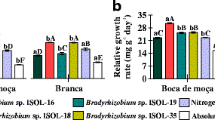Abstract
Physiological characters of symbiotic mutants of pea were studied: nodulation, activities of nitrogenase and nitrate reductase, chlorophyll content in leaves and their water-holding capacity, biomass accumulation, and nitrogen forms. The parameters reflecting the genotype state of the macrosymbiont under soil conditions considerably varied. Supernodulation mutants stood out against symbiotic pea genotypes by high contents of chlorophyll and nonprotein nitrogen compounds, high nitrogenase activity, and low nitrate reductase activity. The efficiency of the legume-rhizobium symbiosis was largely mediated by the macrosymbiont genotype. The highest atmospheric nitrogen fixation (50–80%) was observed in the parental pea varieties. Despite the highest nitrogenase activity in the nodules, the supernodulation mutants were inferior to the parental varieties by the nitrogen fixation capacity (40–60%), which was due to their low productivity.
Similar content being viewed by others
References
Agrokhimicheskie metody issledovaniya pochv (Agrichemical Methods for Soil Study), Moscow: Nauka, 1975, p. 383.
Brei, S.M., Azotnyi obmen v rasteniyakh (Nitrogen Metabolism in Plants), Moscow: Agropromizdat, 1986.
Breseanu, A.G., Davis, B.G., and Schimadacuro, R.H., Ultrastructural Effects and Translocation of Methyl-2 (2,4 Dichlorphenoxy-Phenoxy) Propanoate in Wheat (Triticum aestivum L.) and Wild Oat (Avena fatua), Canad. J. Bot., 1981, vol. 54, pp. 2038–2048.
Gavrilenko, V.F., Laydgina, M.E., and Khandobina, L.M., Bol’shoi praktikum po fiziologii rastenii (Manual of Plant Physiology), Moscow: Vysshaya Shkola, 1975.
Gusev, N.A. and Sedykh, N.V., Current Methods to Study Water State and Molecular Mechanisms of Water Metabolism in Plant Cell, S.-Kh. Biol., 1971, vol. 6, no. 6, pp. 930–939.
Hardy, R.W.F., Holsten, R.D., Jackson, E.K., and Burns, R.C., The Acetylene-Ethylene Assay for N2 Fixation: Laboratory and Field Evaluation, Plant Physiol., 1968, vol. 43, no. 8, pp. 1185–1207.
Havelka, U.D., Boyle, M.G., Hardy, R.W.F., Biological Nitrogen Fixation, in Nitrogen in Agricultural Soils, Madison: Am. Soc. Agron., 1985, pp. 365–413.
Izmailov, S.F., Azotnyi obmen v rasteniyakh (Nitrogen Metabolism in Plants), Moscow: Nauka, 1986.
Kochergin, A.E., Fertilization Efficiency on Chernozems in Western Siberia, in Agrokhimicheskaya kharakteristika pochv SSSR. Raiony Zapadnoi Sibiri (Agrochemical Description of Soils in the USSR. Western Siberia), Moscow: Nauka, 1968, pp. 316–336.
Kretovich, V.L., Obmen azota v rasteniyakh (Nitrogen Metabolism in Plants), Moscow: Nauka, 1972.
Kuzyakov, Ya.V., Tracer Studies of Carbon Translocation by Plants from the Atmosphere into the Soil (A Review), Pochvovedenie, 2001, no. 1, pp. 36–51.
Maevskaya, S.N., Egorova, E.A., and Bukhov, N.G., Effect of Elevated Temperature on Nitrite and Nitrate Reduction in Leaves and Intact Chloroplasts, Fiziol. Rast., 2003, vol., 50, pp. 675–679.
Mishustin, E.N., Mikroorganizmy i produktivnost zemledeliya (Microorganisms and Agricultural Productivity), Moscow: Nauka, 1972.
Nazaryuk, V.M., Balans i transformatsiya azota v agroekosistemakh (Nitrogen Balance and Transformation in Agroecosystems), Novosibirsk: Nauka. Sib. otd-nie, 2002.
Nazaryuk, V.M., Sidorova, K.K., Shumnyi, V.K., and Klenova, M.I., A New Method to Evaluate the Efficiency of the Legume-Rhizobial Symbiosis under Field Conditions, Agrokhimiya, 2003, no. 1, pp. 61–67.
Nazaryuk, V.M., Yakutina, O.P., and Klenova, M.I., The Role of Soil Resources, Nimeral Nutrition, and Symbiotic Nitrogen Fixation in High Plant Productivity, S.-Kh. Biol., 2004a, no. 5, pp. 13–21.
Nazaryuk, V.M., Klenova, M.I., Kalimullina, F.R., and Sidorova, K.K., The Role of Soil Properties, Fertilizers, and Plant Genotype in the Efficiency of the Legume-Rhizobial Symbiosis, in Mater. IV s’ezda Dokuchaevskogo o-va pochvovedov. Kn. 2 (Proc. IV Conf. Dokuchaev Soil Sci. Soc.), Novosibirsk: Nauka-Tsentr, 2004b.
Nicolas, M.F., Arrabal Arias, C.A., and Hungria M. Genetics of Nodulation and Nitrogen Fixation in Brazilian Soybean Cultivars, Biol. Fertil. Soils. 2002, vol. 36, no. 2, pp. 109–117.
Pekker, E.G. and Tokarev, B.I., Agrochemical Variant of the Method to Evaluate the Nitrate-Reducing Capacity of Cereal Crops, Sib. Vestn. S.-Kh. Nauki, 1982, no. 6, pp. 83–85.
Peterburgskii, A.V., Praktikum po agronomicheskoi khimii (Practical Course in Agronomic Chemistry), Moscow: Kolos, 1968.
Pleshkov, A.S. and Kokareva, V.A., USSR Inventor’s Certificate No. 1329680, Byull. Izobret., 1987, no. 30.
Posypanov, G.S., Methodical Aspects of Studying Symbiotic Activity of Legume Crops under Field Conditions, Izv. Timiryazevsk. S-kh. Akad., 1983, no. 5, pp. 17–26.
Pryanishnikov, D.N., Azot v zhizni rastenii i v zemledelii (Nitrogen in Plant Life and Agriculture), Moscow: Izd-vo s.-kh. lit, 1953.
Shumnyi, V.K., Sidorova, K.K., Klevenskaya, I.L., et al., Biologicheskaya fiksatsiya azota (Biological Nitrogen Fixation), Novosibirsk: Nauka. Sib. otd-nie, 1991.
Sidorova, K.K. and Shumnyi, V.K., Creation and Genetic Study of a Collection of Symbiotic Mutants of the Pea (Pisum sativum L.), Genetika, 2003, vol. 39, no. 4, pp. 501–509.
Stevenson, F.J., Cycles of Soil Carbon, Nitrogen, Phosphorus, Sulphur, Micronutrients, New York: J. Wiley & Sons, 1986.
Streeter, J.G. Symbiotic Nitrogen Fixation, in Plant-Enviroment Interactions, Wilkinson, R.E., Ed., New York: Marcel Dekker, 1994, pp. 245–62.
Tokarev, B.I. and Shumnyi, V.K., Genetic Control and Mechanisms to Regulate Nitrate Reductase Activity, Genetika, 1976, vol. 12, no. 3, pp. 141–152.
Trepachev, E.P., Agrokhimicheskie aspekty biologicheskogo azota v sovremennom zemledelii (Agrochemical Aspects of Biological Nitrogen in Current Agriculture), Moscow: Agrokonsalt, 1999.
Troitskaya, G.N., Gadimov, A.G., and Izmailov, S.F., The Role of Small Nitrate Doses and Symbiotically Fixed Nitrogen in Nitrogen Nutrition during Soybean Ontogeny, Fiziol. Rast., 1993, vol. 40, pp. 448–457.
Author information
Authors and Affiliations
Additional information
Original Russian Text © V.M. Nazaryuk, K.K. Sidorova, V.K. Shumnyi, F.R. Kalimullina, M.I. Klenova, 2006, published in Izvestiya Akademii Nauk, Seriya Biologicheskaya, 2006, No. 6, pp. 688–697.
Rights and permissions
About this article
Cite this article
Nazaryuk, V.M., Sidorova, K.K., Shumny, V.K. et al. Physiological and agrochemical properties of different symbiotic genotypes of pea (Pisum sativum L.). Biol Bull Russ Acad Sci 33, 559–567 (2006). https://doi.org/10.1134/S1062359006060057
Received:
Issue Date:
DOI: https://doi.org/10.1134/S1062359006060057




